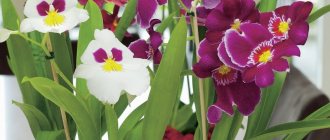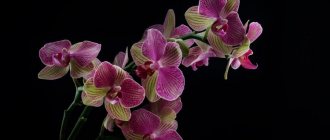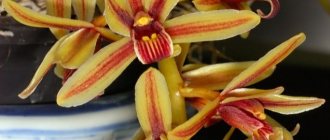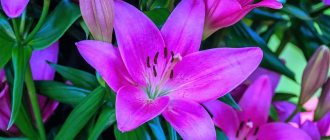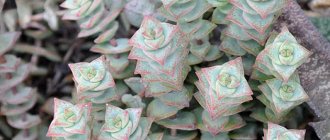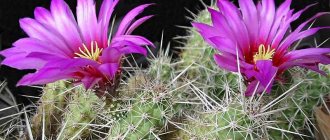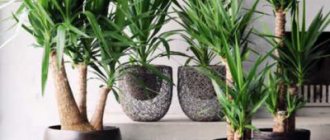One or another person who notices an orchid that is unique in its beauty will undoubtedly stop to admire it, being blinded by the beauty of this flower. There are about 750 types of variations, and approximately 30,000 hybrid models. Moreover, all of them, without exception, have their own characteristics. Plants are known for their grace throughout the world. They are attracted by the hot atmosphere with its significant dampness and temperature changes.
* The rating is based on the number of requests to the Yandex search engine.
Appearance
Externally, orchids are so diverse that a person not initiated into the topic will not even understand that these are plants of the same genus. It is easy to understand how to determine the type of orchid by its leaves; each variety surprises with its own characteristics. Tropical beauties are monopoidal, consisting of one bush with one growing point, as well as sympoidal, which have several pseudobulbs or tubers. The leaves can be fleshy, thick, wide in phalaenopsis, thin in dendrobium, cattleya, thin and soft in oncidium, paphiopedilum. collected in a Christmas tree at Vanda, Ascocenda.
Cattleya
There are single-leaved and double-leaved. These features provide a chance to determine the variety of Cattleya orchid, of which thousands have been bred. New sprouts appear next to last year's ones, and it is on them that the covers with flower stalks appear. The stems look like short succulent formations, called pseudobulbs, which store a supply of nutrients. Each forms 1-2 fleshy, narrow, elongated, dense leaves. Cattleyas have the richest color range: white, yellow, green, red, burgundy, pink, crimson, purple, brown, almost black. Flowers range from small 4-5 cm to large 10-15 cm. The lip is long, elongated, funnel-shaped or tubular in shape with fringe along the edges. Its color is different from the other petals.
Cumbria
The easiest way to determine the type of Cambria orchid by its leaves is to estimate the thickness and length of the leaf blade. Most orchids have fleshy foliage, but not Cambria. The greens are thin, long, up to 40 cm tall, pliable. The sheets can fold into a pot if there is a lack of humidity, and also change color to a darker one if there is a lack of lighting. Cambria is a hybrid bred from 5 different varieties: oncidium, brassia, miltonia, cochloide, odontoglossum. The flowers are delicate, the petals are thin and intricately shaped. The lower 2 petals form a kind of beard, differing in color, the buds are pointed, bloom for 5-7 weeks. Leaves and flower stalks emerge from massive pseudobulbs, plump in appearance. Primary colors: yellow, white-red, burgundy, white, orange, brown.
Dendrobium
You will learn more about how to identify the type of dendrobium orchid by learning about its structure. The height of the bush is from 40 to 90 cm, the bulbs look like stems, on them dense leaves 5-10 cm long grow one above the other on both sides. Peduncles and aerial roots usually appear from their axils. 1-4 flowers grow on stalks, which have a pleasant aroma, their diameter is 5-8 cm. Main colors: white, pink, crimson, purple, white with colored edges. There are orange and green. Only new shoots are capable of producing flower stalks. Old ones can be used for propagation by cuttings, cutting the branch into 3-4 parts with 1-2 dormant buds on each. A pressing problem for lovers of dendrobiums is how to determine the variety of the dendrobium-phalaenopsis orchid, because it grows differently: peduncles grow from the tops of the bulbs, and not from the axils, the inflorescences themselves are smaller in size 3-5 cm, there are more of them on the peduncle, up to 50 pieces.
The orchid is liked by many gardeners who are not at all opposed to decorating their own home with this beautiful plant. However, a flower will become a decoration only if it is forced to bloom again - and this is not an easy task, requiring compliance with a number of conditions, the presence of certain external factors and provision of proper care. Otherwise, there will be no flowering, and the dream of a beautiful orchid in your own home will remain just a dream.
So what should be done to overcome the stubbornness of the orchid and make it bloom? To do this, it is enough to follow 9 specific care rules, which will be described in detail below.
Rule 1: age matters a lot
Typically, orchids bloom at the age of one and a half to three years, depending on the specific type of flower. Therefore, if an orchid is suddenly in no hurry to bloom, you need to ask about its age - perhaps the flower is simply too young to bloom. It is easy to calculate the age of an orchid by the number of shoots. An adult plant, already ready to bloom, will have approximately 5-8 of them. A young one will naturally have fewer shoots. But early flowering of an orchid most often leads to the death of the plant, since a young flower, as a rule, cannot recover after early flowering.
Rule 2: follow the roots
Since orchid roots take an active part in the process of photosynthesis, it is very important to provide them with the appropriate amount of natural light. This is easy to do if you plant the flower not in classic ceramic pots, but in modern ones - transparent, made of plastic, and equipped with a sufficient number of drainage holes. This will be the best solution that will allow the roots to develop without any problems. But pots with corrugated walls or sharp edges can cause harm to the orchid’s roots, and therefore it is better to avoid such containers from the beginning.
Rule 3: no need to move the pot
This is another purely orchid whim - the plant really doesn’t like being moved. Any change in lighting conditions becomes a terrible stress for the orchid, after which there can be no talk of growth. Hence the third rule: it is better not to move the orchid pot at all, and even if you do move it, then try to maintain the same type of lighting for the plant as accurately as possible. And it is better to completely avoid moving the flower during watering and during the period when the peduncle appears.
Angrecum one and a half feet (Angraecum sesquipedale)
This is the largest species of orchid from the genus Angrecum. Plant of monopodial type. Forming trunk up to a meter in height, erect. The leaves are two-rowed, completely conceal the stem, folded at the base, with blunt ends. There is a dense waxy coating on the gray-green leaf blades. The shape is elongated, about 35 cm long, 3 cm wide. It produces 3-5 peduncles shorter than the leaves. The inflorescence contains from 2 to 6 flowers.
The flowers are in the shape of a large star, about 17 cm in diameter. This species has the most intense night aroma, pleasant, with a powdery trail. Solid, creamy white color. The shape of the lip is lanceolate, with a sharp tip and a long (up to 30 cm) light green spur.
Angrecum one and a half feet is called the comet orchid or the star of Madagascar.
There is an interesting story associated with the plant. In 1862, Charles Darwin, studying the structure of the flower, suggested that it could only be pollinated by a large night hawk moth. A new subspecies of the insect was discovered in 1903 and the specific epithet “praedicta” was assigned to it.
